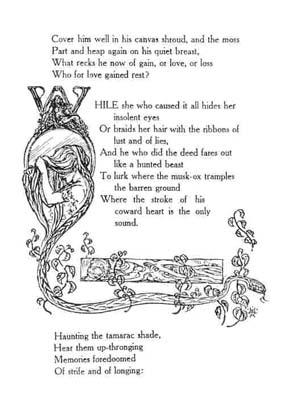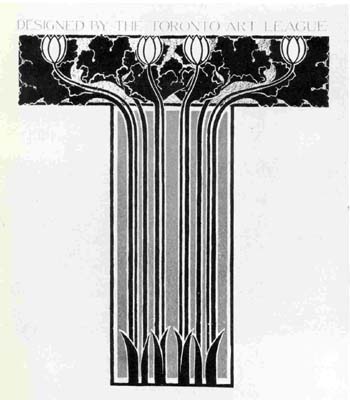
Bulletin 7 (IV:1), 1966
Home
Français
Introduction
History
Annual Index
Author &
Subject
Credits
Contact
![]()





Book
Illustration and Design By Canadian Artists 1890-1940 with a list of books illustrated
by
members of the Group of Seven
by Sybille
Pantazzi, Librarian,
The Art Gallery of Toronto
Résumé en français
Pages 1 | 2 |
3 | 4
Although Canadiana is so eagerly sought after at present,
native book illustration seems to have attracted little attention.
To my knowledge comparatively few articles have been devoted to this
subject and the standard books on Canadian art refer only
incidentally, if at all, to the artists as illustrators. (1) Certain
books such as Louis Hémon's Maria Chapdelaine (1933) with
Clarence Gagnons brilliant illustrations and Le Grand Silence
Blanc (1928) by Rouquette, also illustrated by Gagnon, are well
known, and of course the work of F. S. Coburn, Arthur Heming, Ernest
Seton-Thompson, C. W. Jefferys and Thoreau MacDonald is familiar to
those who are interested in Canadian books. It is astonishing
however that, so far, the contribution of Canadian artists to book
illustration and design from the 1890's to the 1940's has been
overlooked. A preliminary survey, mainly based on the collection in
the library of the Art Gallery of Toronto, has revealed an
unsuspected quality and diversity in their graphic work during this
period and has uncovered new aspects of the work of some individual
artists.
Too few opportunities to illustrate books existed in Canada before
the 1890's, but in the 1870's artists like William Armstrong,
William Cruikshank, F. M. Bell-Smith and Henri Julien contributed to
the Canadian Illustrated News. The most ambitious undertaking
of that period was Picturesque Canada (1882), which contained
wood-engravings after the designs of William Raphael, Otto Jacobi,
Henry Sandham and Lucius O'Brien. The first publication, however, in
which the artists had a free hand and some scope for decorative
design was the Calendar of the Toronto Art Students' League. Founded
in 1886 by a group of artists - A. H. Howard, J. D. Kellyand C. M.
Manly were among the first members, and were joined later by Robert
Holmes, F. H. Brigden, R. W. Crouch, C. W. Jefferys and others-the
League published its first Calendar in 1892. (2) Although the subject
matter remained Canadian, the style of the covers and title-pages of
the subsequent Calendars (which appeared annually until 1904) soon
began to reflect two important artistic movements from abroad: the
Arts & Crafts movement and Art nouveau.
One of the main sources known to have been consulted by the
members of the League was Joseph Pennell's Pen Drawing and Pen
Draughtsmanship (1894). (3) This book was a lavishly illustrated
international survey which included examples of the best
contemporary illustration in line, a technique which, owing to the
development of photo-engraving, had superseded wood-engraving since
1880. Other models available to the League were the American and
English illustrated magazines, Harper's, The Century Magazine and
Punch,
and after 1893, probably The Studio, although
Colgate only mentions the first three in his history of the League.
It is likely that the members of the League were also familiar with
Walter Crane's The Decorative Illustration of Books (1896).
An echo of Crane's style can be seen for example in the title-page
of the Calendar for 1902 (Fig. 3), but the freshness and delicacy of
A. H. Howard's pale blue and brown design, symbolizing the Canadian
seasons and sports, has its own individuality. Walter Crane was the
most popular of the disciples of William Morris, and it was he who
formulated the aim of the Arts and Crafts movement as being 'to turn
our artists into craftsmen and our craftsmen into artists'. The
reform of book design advocated by this movement emphasized the
treatment of book illustration primarily from the decorative point
of view. (4) This tendency is first seen in Canada in the Calendars
of the Toronto Art Students' League.
R. H. Hubbard and Eric Arthur, respectively, have discussed the
influence of Art nouveau on the Group of Seven and on
architecture in Toronto. (5) The Calendars of the League provide yet
another aspect of this influence, that on book design. Art
nouveau was essentially an ornamental style and was at its best
and most characteristic in the arts of the book. Its distinguishing
features-nature formalized into rhythmic and repeated outlines, the
flat pattern and the long undulating line - are present in R. Weir
Crouch's designs for the covers of the Calendars for 1898 and 1899
(Figs. 2 & 7) and in the design of Robert Holmes (Fig. 4). Based
on Canadian floral motifs, they have both vigour and style and are
excellent examples of the vernacular version of Art nouveau. A.
H. Howard's symbolic illustration (Fig. 5) is also interesting
because it treats a typical Art nouveau theme - the
metamorphosis of a maiden's hair into a serpent - but in a
domesticated manner from which the erotic sting has been removed.
The activity of the Toronto Art Students' league ceased in 1904, (6)
and the last Calendar issued was for that year, but its influence
had lasting and far-reaching effects on Canadian book design. Before
discussing these effects, mention must be made of The Book of the
Victorian Ball (Toronto, Rowsell & Hutchison, 1898), a
handsomely produced souvenir of a costume bail held in Toronto on 28
December 1897. In its, Advertisement' James Mavor wrote: 'The growth
in Canada and especially in Toronto of a large group of artists,
competent not alone as colourists, but also as draughtsmen in line,
is 50 recent that its existence has, perhaps, hardly been suspected.
The chief interest of the book lies in that it contains a sufficient
number of really masterly drawings to justify the belief that there
is a vigorous artistic movement in Canada...As regards the technique
of reproduction, the book has also a certain historical interest.
The facsimiles of the pencil and water-colour drawings are
accomplished by methods which, if not absolutely new, are new to
Canada: the processes of photographic reproduction upon copper or
zinc which have superseded wood-engraving.' Oddly enough, the league
is not mentioned although the illustrations in its Calendars had
been reproduced by the 'new' technique since 1893. On the whole,
compared to the decorative designs and landscapes of the Calendars,
the figure studies in The Book of the Victorian Ball seem
curiously old-fashioned and conventional.
Next Page | Local
illustrators
1 | 2 |
3 | 4
Annual Index | Author & Subject | Credits | Contact
This digital collection
was produced under contract to Canada's Digital Collections program,
Industry Canada.
"Digital
Collections Program, Copyright
© National Gallery of
Canada 2001"